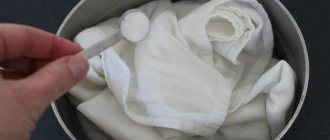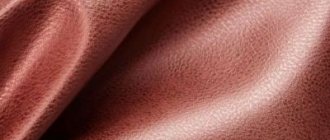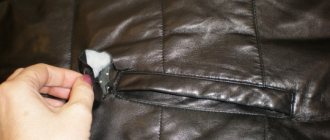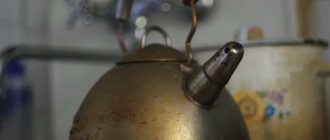Tatyana Panasenko Cleaned a jacket for 20,000 ₽
Last year I was in the forest, got caught in the rain, and then slipped and fell head over heels into a ravine. I am unharmed, but my leather jacket worth 20 thousand rubles was damaged - it collected all the dirt. I had to wash it by hand, although I CAN'T get it wet. The jacket dried, applied balm - I wore it without spoiling. I won’t wear it to the forest again! Let's figure out how to care for a leather jacket at home.
Saphir cream-balm restores and nourishes natural skin. Manufacturer: France. Price — 715 rubles
Cleaning and drying a leather jacket
Leather is a material on which any stains or scratches become visible. Taking your clothes to the dry cleaner every time is an expensive proposition. There are times when a jacket needs cleaning urgently. This is when simple methods for cleaning leather clothes at home will come in handy.
Removing scuffs and greasy areas
Scuffs are a common occurrence on leather goods. A special paint in the form of an aerosol or powder diluted in water will help restore them to their previous appearance. Before using the product, clean the skin from dust with a damp sponge. The paint is applied in an even layer to the surface of the jacket. Excess is removed with a soft sponge. The jacket should dry naturally, usually this happens in at least two hours.
Greasy areas of a jacket appear in the collar, pockets and sleeves, where clothing often comes into contact with human skin. Such stains can be eliminated using the following method, which requires ethyl alcohol, lemon juice (you can simply cut the lemon into two halves) and a glycerin solution.
- The treatment area is thoroughly cleaned of dust;
- A cotton swab is moistened in ethyl alcohol, and the skin is thoroughly wiped with it;
- Afterwards the skin is rubbed with lemon juice;
- Then lubricate with glycerin solution.
After treatment, the jacket is left to dry for several hours.
You can prevent your collar from getting dirty by constantly wearing scarves and scarves around your neck. Also, at least once a week, problem areas should be treated with any detergent using a napkin.
Removing salt stains
Salt stains on leather items appear from natural precipitation - snow or rain. Here's how to remove water stains:
- Dry the clothes thoroughly. All existing drops on the surface are wiped off with a soft cloth or sponge without strong pressure.
- Particularly damp areas can be dried by ironing them through a cotton cloth.
- After the jacket has dried, it is treated with a water-repellent grease product such as Salton, Grangers and Nikwax.
There are also ways to remove salt stains using improvised means:
- Vinegar. 3 teaspoons of 9% acid are diluted with a teaspoon of water. Use this solution to wipe away the stains, after which the jacket should dry.
- Castor oil. The product in its pure form is applied to the surface, after which the treated area is wiped with a dry cloth to remove excess oil.
- Alcohol. Use a cotton pad soaked in liquid to wipe the dirty area.
How to deal with various contaminants
With constant wear, leather items are exposed to a variety of negative environmental influences. Methods for cleaning a leather jacket at home largely depend on how the clothing is soiled and which areas of it are damaged. Let's take a closer look at each case.
Paint marks
Dyes are very difficult to remove from all materials. In some cases, it is impossible to get rid of them. But you can remove paint stains from a leather jacket using pure gasoline or turpentine:
- Soak a cotton pad or dry cloth in the selected solution and wipe the stained areas.
- If the stain cannot be completely removed the first time, then you need to repeat the procedure after 20-30 minutes.
- For stubborn or old paint stains, use a small amount of ammonia along with gasoline or turpentine.
- The persistent unpleasant odor from these substances can be removed by wiping the jacket with a vinegar solution.
- At the end of the procedure, lubricate the treated areas with glycerin or any nourishing cream.
Dark dust coating
It happens that a jacket hangs in the closet for a long time or is simply not treated with special means. This may cause the product to darken and become covered with a layer of dust. In this case, cleaning using regular baking soda, which is found in every home, will help:
- Mix 1-2 tsp. soda with water so that you get a mushy mass.
- Apply the mixture to a sponge or cotton pad and wipe the entire surface of the clothing.
- Leave the baking soda on for 5 minutes, then rinse it off with water.
Salt coating
Sometimes the reagent from the street gets onto our things through splashes from puddles. Salt dries quickly, eating into the material and destroying it. In this case, when you go home, do the following:
- Soak a napkin or cloth in the vinegar solution and remove the salt from the product.
- After cleaning, treat it with cream or glycerin.
Ballpoint pen and ink marks
Ethyl alcohol will do a great job with this kind of dirt:
- It is necessary to moisten a cotton pad or napkin in it.
- Next, you should wash the stained areas on leather items.
After this procedure, the jacket will shine like new.
Restoring elasticity
Over time, the leather on clothing loses its elasticity and becomes less soft and shiny. But before you give up your favorite thing, try to return it to its original appearance.
Castor oil
Beat 50 grams of this product with egg yolk. The resulting mixture is applied evenly to the skin. After the jacket is dry, remove excess with alcohol.
Laundry soap
Dissolve half a bar of soap in a liter of hot water, add 1.5 teaspoons of ammonia and a teaspoon of fish oil. Rub the skin with this mixture.
Butter
Melt butter in warm water at the rate of 3/3. Add ammonia there in a ratio of 3/1. Thoroughly lubricate the surface of the jacket with this solution.
Acetone and ammonia
Wipe the jacket with one of these products and apply glycerin on top. But, since acetone is a good solvent, it is not advisable to resort to its help often.
Leather or substitute
Genuine leather looks practically no different from leatherette
Often, when purchasing an item in a store, we ask the question “Is it made of leather or faux leather?”, because each of us wants to buy a good, high-quality product, and at the same time, it would be nice to pay less. Here enterprising sellers enter the scene, offering customers artificial leather, positioning it as genuine leather. Faux leather is pressed leather that imitates a whole cloth; the difference is that genuine leather is a whole skin taken from an animal and carefully processed. Leather is much stronger and more reliable than leatherette, it serves its owners much longer. When leatherette is at risk of bursting - after a few weeks or months, it depends on the quality. It is possible that high-quality leatherette can last for several years, but most often the products begin to deteriorate much earlier. As you know, a miser pays twice, so it’s better to save a little money and buy a quality item. You can distinguish leather from a substitute by the label on the clothing, the smell and the cuts, which will be hidden in a high-quality leather product. If you press your hands to the product, genuine leather will absorb the heat of your palms, while leatherette will remain cold.
Eliminating scratches
Cracks and scratches appear even on new leather clothes. They are formed as a result of damage and long wear, especially at bends. You won't be able to remove them, but you can disguise them.
Liquid skin
This product looks like a regular cream and is intended for the restoration of leather products. The cream will fill the space caused by damage. It is important to smooth the edges carefully so that the stain does not stand out.
Glycerol
Also, scratches and cracks can be removed with regular glycerin. It is diluted with water at a rate of 1/1 and rubbed thoroughly into the damaged areas of the jacket.
Removing stains
Stains on a leather jacket are very noticeable. Therefore, they must be removed immediately before dirt or grease is absorbed into the skin. The products used to remove stains depend on the nature of the stains.
Fat
- Old and deep greasy stains can be removed with gasoline, acetone or white spirit, but this only applies to clothes made from natural high-quality leather.
- Sprinkle the fresh stain with tooth powder. After it absorbs the fat, carefully remove.
- The easiest way is to place a sheet of paper on the greasy stain and iron it with a hot iron. But this method is effective while the stain is fresh and just formed.
Dirt
Dust and particles of dirt that settle on the skin day after day and eat into it can be removed using the following means:
- Cosmetic makeup remover.
- Alcohol or lemon juice.
- Gasoline or white spirit.
Dip a soft cloth in one of these products and wipe the dirty area of the jacket with it.
Mold
These stains can occur as a result of clothing being stored in a damp place or if the jacket has not been properly cared for. It is important not only to remove a dirty stain, but also to rid clothes of an unpleasant specific odor. Mold is removed as follows:
- Thoroughly moisten the stain with lemon juice, then sprinkle a thick layer of salt on top.
- After ten minutes, carefully clean the jacket.
Glue
You can remove glue stains without a trace using a solution: turpentine and denatured alcohol are mixed in equal parts. This mixture is applied to the stain, and after ten minutes it is cleaned with medical alcohol.
Perfume
Perfume or cologne stains can be removed using:
- Any dishwashing detergent;
- Alcohol;
- Ammonia;
- Glycerin.
Stains on the collar
There are stains on the collar from sweat, perfume, and cream. You can often see traces of foundation on women's jackets. In addition to all the listed methods of cleaning the skin, you can get rid of stains using:
- Baking soda;
- Onion halves;
- Tooth powder;
- A piece of stale bread.
Using all these means, it is necessary to wipe the collar without pressure, and then treat it with glycerin.
Properly stored in a closet
To get rid of creases on faux leather, you can iron the jacket through gauze on the minimum iron setting.
Do not iron natural leather! It is necessary to avoid creases. Photo: 7rubrik.com How to store a leather jacket:
- on hangers . It is best to hang a leather jacket on soft hangers so that there are no creases;
- case. It is better to store a leather item in a special clothing case to prevent dust from settling. A cover made of natural material, for example, cotton, will allow air to pass through so that the skin “breathes”;
- dark closet. Seasonal storage - only in a closet, out of direct sunlight. Their exposure causes the skin to burn out.
Cover for clothes from the Red Cat brand: material - PEVA (breathable), size - 60x100 cm, average price - 90 rubles. Photo: cdn2.top-shop.ru
Removing unpleasant odor
The skin has the ability to absorb different odors, which, when mixed, form a persistent unpleasant odor. To remove it, you need:
- Ventilate by taking it out into the fresh air.
- Remove dirt using one of the following methods.
- Fill the bathtub with hot water, add vinegar or ammonia. Hang a jacket over the bathtub to absorb the steam.
- Wrap the jacket in newspapers for a few days.
- Sprinkle with coffee (only dark colored jacket!).
How to prepare a new jacket for use
After purchasing a leather item, you need to study the care information. After all, care begins by reading the instructions that come with the clothing.
Typically these tips are located on a label that is attached to the lining material. Studying the manufacturer's recommendations will not take too much time, but it will help you avoid making some mistakes.
Getting rid of the smell
The new product has a strong, characteristic odor.
You can get rid of it using freshly ground coffee beans. The jacket must be laid out on a flat surface and sprinkled with dry coffee powder on top. Leave it to absorb the smell for a day, after which it is removed from the product with a soft bristle brush.
ATTENTION! This method is not suitable for natural light leather products.
Making leather waterproof
Before putting on a new item, it is necessary to treat the product with a special composition that repels water.
After such manipulation, the product will become less wet, and any contaminants that appear will be easier to remove. For processing, you need to use the compounds recommended by the manufacturer.
ADVICE. If you have doubts about the quality of the chosen product, it is better to test it on a small area of skin.
You should choose the one located on the inside of the product . The best places to check would be the hem, seam allowance and cuffs.
Caring for a white jacket
You can clean white clothes using the following means:
Milk
By soaking a cloth in milk, you need to wash away dirty stains. The drink will also soften the skin well. You need to use fresh milk, as it contains fats.
Aspirin
Crush the tablets and mix with water to a paste. Apply the paste to the skin and rub thoroughly. Then remove the product with a cloth soaked in clean water.
Hydrogen peroxide
It treats the contaminated area of skin. If the dirt has not disappeared, the procedure can be repeated.
Cosmetic milk
Every woman has makeup remover milk in her arsenal. It is used to remove dirty stains from a leather jacket. Use a cotton swab dipped in a cosmetic product to wipe the stain.
Chalk or starch
A paste is prepared from one of these products and applied to the stain until completely dry. Afterwards, wipe gently with alcohol or glycerin.
Before using the cleaner, test it on a piece of leather!
Methods
Grease stains on sleeves and collars are removed with a solution of glycerin soap, and at the final stage of the procedure, wipe the damp surface.
You can also use another method: place a paper napkin on the dirty area, and then gently iron the problem area with an iron.
When exposed to high temperatures, the paper will absorb fat. Dried dirt should be removed with a damp cloth, which should first be soaked in a soap solution, but it is important to remember that there should not be a lot of water on the leather jacket. Acetone or gasoline can effectively remove paint stains, and the specific smell will evaporate as soon as you treat the stained area with a slice of lemon. A napkin treated with an acetic acid solution will help prevent salt stains that form after precipitation. The faded color of the product can also be eliminated. To do this, treat the surface of the skin with lemon juice, after which it will become shiny again. You can get rid of roughness of the material and cracks using a sponge pre-moistened in a glycerin solution
After this, microcracks will become almost invisible. As an alternative to the glycerin composition, we can recommend regular chicken yolk, which should be beaten in advance. Traces of mold on the jacket are removed using gasoline.
How to restore after washing
As a result of washing, the skin loses all fattening substances, which is why it becomes brittle and even decreases in size. You can restore the attractive appearance of your jacket in the following ways:
- Generously lubricate the surface of the jacket with glycerin or castor oil;
- Leave in oiled form for two hours;
- Then carefully knead and stretch with your hands;
- If it does not help, repeat the procedure.
A good recovery method is steaming. You can steam your jacket by hanging it over a bathtub of hot water.
It is better to avoid washing leather products, as their restoration requires a lot of effort.
Tips for suede
Suede clothing requires special and delicate care. The peculiarity of caring for it is proper dry cleaning and regular treatment with special products. To care for a suede leather jacket you will need:
- 1Universal impregnation for this type of leather, which will protect it from moisture and dirt. This product covers the fleecy surface and does not allow dust and other contaminants to penetrate deeply into the material. Thanks to these products, cleaning is quick and easy.
- 2Special eraser and brush. Remains of dust and dirt are removed from the skin only after it has completely dried. Using a brush with soft bristles, dirt is removed from the surface; it is worth cleaning in one direction, and not rubbing in one place. Then use an eraser to go over the entire surface to be cleaned. Using a springy sponge or brush, fluff the lint on the clothes and set it in one direction.
To remove greasy stains and greasy, worn-out areas on suede, you can use:
- 1Ammonia, take about 10 drops of alcohol per 250 ml of water. Use this solution to wipe the stain. After treatment, wipe the fabric with a clean damp cloth and dry the item. Drying must be done in a dry room, away from radiators.
- 2Vinegar can also cleanse the skin of greasy stains. Vinegar is diluted with water in the following proportion: add 15 ml of vinegar to 250 ml of water. Dip a cotton pad into this solution and wipe the stained areas with it. Residues are removed with a clean damp cloth.
- 3Dissolve hydrogen peroxide in water and wipe the jacket with this solution. Peroxide is added to 0.5 cups of water in the amount of 1 tsp.
If creases appear on a leather jacket, they can be removed with steam. To do this, fill the bathtub with hot water and hang the jacket over the water for 10–15 minutes. The vertical steam mode on the iron is also perfect; the main thing is to correctly calculate the distance and temperature on the device.
It is important to remember that before carrying out any cleaning measures on leather clothing, you should initially test them on the inside of the product, hidden from view.
Restoring the color of a leather jacket
When exposed to the sun or frequent exposure to rain, the jacket may fade and lose its natural color. Restore color using special paint. The main thing is to choose a product that matches the jacket.
Aerosol paint
The area to be painted is cleaned of dust and dirt and degreased with alcohol. From a distance of no closer than 20 cm, spray paint from a can onto the problem area of the jacket until the desired color is obtained. Remove excess with a sponge or soft cloth.
Powder dye
Powder paint is quite easy to use. The solution is prepared according to the recommendations given on the package. Boiling water is used to prepare it. After the solution has cooled to +45 degrees, clothes are immersed in it for 2-3 hours. After dyeing, the jacket is rinsed several times until the water becomes clear. Dry clothes by hanging them on hangers in a cool, dark place.
Storing leather outerwear
One of the rules for keeping a leather jacket presentable is systematic care. It consists of simple actions that will protect clothes from external factors and prolong their life:
- The item of clothing should be stored on a hanger in a specially designated compartment of the closet.
- The wardrobe compartment must be of appropriate dimensions so that the jacket can hang freely without the threat of wrinkles.
- You cannot store outerwear in bags, as they need air.
- During the period when the jacket is not worn, it is necessary to periodically remove it from the wardrobe and dry it in warm fresh air.
What not to do
Many people use the old fashioned way to remove creases and wrinkles from clothes that are ineffective. At best, they do not give the desired result; at worst, they worsen the appearance of the product.
Let it sag
If you need an item urgently, then this is not the best option. It is not suitable for products made of thick, rough leather. A jacket, dress, or raincoat needs to hang on hangers for several days for shallow, fresh creases to disappear.
Smoothing with hot air
It is not recommended to use a hairdryer on folds. A blast of hot air will not smooth them out. It will dry out natural leather, making it rough and tough.
Using hot water
It is not recommended to immerse things made of genuine leather in hot water. With prolonged exposure to hot liquid, they lose elasticity, color, and shape.
Stretching folds
When you stretch the folds of the skin with your hands, the item becomes deformed. The shape is not completely restored, convex areas appear.
Breaking in
A long walk in the rain cannot restore your skin to its former smoothness. Exposure to damp air softens it, but only small creases are smoothed out.
Review of professional leather care products
If you have leather goods in your wardrobe, you need to stock up on products to care for them.
| Protective creams | Masks problem areas. | Popular manufacturers of cosmetics for leather care: "Salton" "Grangers" "Nikwax" "Leader" "ColourLock" |
| Stain removers | Remove stains | |
| Spray cleaners | ||
| Air conditioners | Removes odors and softens skin | |
| Disinfectants | Fights mold and parasites |
Home methods
When it is not possible to purchase special creams and aerosols for the care of leather clothing, you can use folk remedies. They are very easy to prepare, affordable and no less effective.
Popular recipes:
- You can remove dirt from a dusty surface with a damp cloth. If dirt is stuck, it is recommended to use a soap solution, but do not get the product too wet.
- If the sleeve collar begins to shine, or a greasy stain appears on a winter or other leather jacket, you need to use soap that contains glycerin. It should be dissolved in water. If the stain has appeared recently, then you should put thin paper on it and iron the area. The fat will begin to melt and be absorbed into the napkin. This is the best method for this type of stain and greasy stains.
- If paint accidentally gets on your jacket, you need to use acetone or gasoline as quickly as possible (rub the damaged area with a cloth soaked in liquid). The pungent unpleasant aroma can then be removed by additionally sprinkling with lemon juice or wiping with a piece of this citrus fruit.
- When salt stains appear on a dry leather jacket after heavy precipitation (after snow, hail, rain), it is recommended to moisten a napkin in vinegar and treat the damaged areas.
- If leather products have lost their shine, then, again, you need to use lemon. You need to squeeze the juice out of it and rub it all over your jacket. After this it will shine again. But after this acid it may become too dry, so it is recommended to use additional castor oil.
- If mold appears on leather material, the reason will be non-compliance with storage and care rules. Foci of fungus must be destroyed with gasoline, and then wipe the product with a napkin.
- Dirt on a brown jacket can be dealt with using coffee grounds. It must be wrapped in a piece of soft cloth. You can also use orange peel to add shine to the material. Such products are also suitable for a black jacket.
- They also use a regular onion. It must be cut, and then rub the surface of the product with it until the cut of the root crop becomes dark. Then you need to separate the thin layer with a knife and continue processing again. After this, the jacket should be rubbed with a piece of flannel fabric.
- Over time, leather products begin to become rough and cracks appear on them. To prevent this, it is necessary to periodically treat the material with a mixture of glycerin and water. Thanks to this, cracks will not be noticeable, and the fabric will become softer. You can also use regular Vaseline or egg white. The white must be beaten and then applied to the product. After this, you do not need to wait for the layer to dry, but immediately wipe it off with a wet cloth.
If a leather jacket has inserts made of velor, suede or nubuck, then it is necessary to take into account the features of such materials. They are cleaned with alcohol solutions. But products containing wax cannot be used, as they cause the pile to stick together. It is better to stick a film around the inserts when cleaning, and treat the material itself with an aerosol.
How to make homemade leather jacket care products
As a rule, professional cosmetics for leather products are expensive. In addition, the product can run out at any time, and the clothes need cleaning right now. In this case, you should always keep the following products in stock.
Glycerin and oil
The first assistants in the care of leather products. Glycerin and oil, for example castor, can:
- Restore softness and elasticity to the jacket;
- Add shine;
- Remove stains.
The sequence of application is as follows: first you need to lubricate the surface of the jacket with oil and leave for a while, depending on the degree of contamination, then remove excess oil with glycerin. The older the jacket, the better and more it will absorb oil.
Soap and ammonia
A soap-ammonia solution, which is used to cleanse the skin of stains, as well as to remove grease, is prepared according to the following algorithm: ammonia and ordinary liquid soap are mixed in equal parts and mixed thoroughly. This solution is used to lubricate the dirty areas of the jacket, most often the collars.
Lemon juice + alcohol
These products do not mix, but are used together to clean a leather jacket. The surface is degreased with alcohol, all particles of dust and dirt are removed. Lemon juice can:
- Remove difficult stains such as ink and blood.
- Restore shine and softness;
- Rid your jacket of unpleasant odors.
Orange peels
For cleaning, you will need fresh orange peel, as it contains essential oils. Orange peels are rubbed on the skin in order to:
- Give it shine;
- Remove unpleasant odor;
- Protect from moths and other pests in the summer.
For one jacket you need 3-4 oranges. Moreover, this way you can only clean dark leather; orange juice leaves traces on light-colored products.
Coffee grounds
This product is good for cleaning suede products, as well as brown leather jackets. To remove stains, the product is prepared in this way: ground coffee is mixed with water or unboiled milk until it becomes a thick porridge. Wrap the grounds in a soft cloth and use it to clean dirty areas. You can also use the coffee grounds left in the cup.
Effective means
How to choose the right product
First you need to decide what kind of leather is on the jacket:
- Smooth skin. Used in most modern products. This jacket is easy to care for and absorbs less moisture. After rainy weather, it is enough to wipe it with a cotton cloth.
- Nubuck and velor are materials with a matte surface. A spectacular look is obtained after sanding the skin. Caring for a jacket is much more difficult; all dirt is removed with special products or dry cleaning.
- Suede leather. Popular for making lightweight jackets. The surface “breathes”, it is comfortable to be in such clothes. It is difficult to care for, stains are difficult to remove, and the service life of the product is much shorter than that of smooth leather.
How to properly care for a leather jacket depends on the type of upper material. The industry produces special products for different types of leather surfaces. For suede leather, you should purchase sprays that prevent fibers from sticking together and protect the surface from contamination with dust. Large-mesh sponges will help treat shiny areas without damaging the delicate suede surface.
Remedies for a smooth skin surface are varied, in some cases they can be replaced or supplemented with home remedies such as castor oil, glycerin.
Vaseline and alcohol
Manufacturers allow any alcoholic drinks that contain alcohol to be used for softening.
How to soften leather jackets at home:
- Soak a cotton cloth in a solution made from 1 part vodka and the same amount of water.
- After treatment, the skin will immediately become soft. You just need to repeat the procedure again.
- Then use Vaseline. Apply it on your jacket with your fingers, be careful if your nails are long. In this case, put on gloves and thoroughly rub Vaseline into the skin.
This method is considered one of the best. This option to make the skin softer is welcomed by manufacturers, dry cleaners and studio workers.
Glycerol
Glycerin alone cannot be used as a separate emollient.
It is used in combination with beams, a slice of lemon and warm water.
How to soften the skin - algorithm of actions:
- First add the whipped whites. Leave for 4 hours. After the allotted time for the procedure has expired, remove with a damp cloth.
- The second step is to treat the surface with a slice of lemon. Can only be used on light-colored jackets, because the acid contained in this citrus has a bleaching effect. After two hours, the product is wiped again with a damp cloth, then dry.
- And the last - third step - applying glycerin. Soak a cotton pad or soft cloth in the oily liquid and wipe the skin. After 8 hours, the glycerin is also removed and conditioner is applied.
After such manipulation, the skin becomes softer and more elastic. The jacket is more pleasant to wear and does not cause discomfort.
Application of air conditioner
In addition to storing leather products in a climate-controlled environment with a relative humidity of 40-50%, it also requires regular care and proper cleaning.
Use conditioner. This product will soften the material, giving it the necessary moisture.
Leather conditioners are designed to help protect the fabric from drying out. Simply apply the product to the surface of the product, rubbing gently. The conditioner seeps into the pores of the skin, moisturizes and softens it from the inside.











